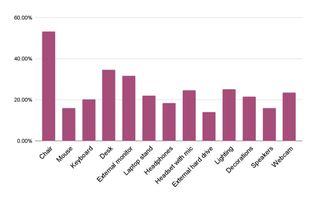More than a quarter of people who recently responded to a TechRadar Pro and SmartBrief survey said they experienced physical pain such as neck or back pain from working from home during the pandemic.
In the survey of 1,200 US-based professionals, 90% of respondents said they had worked from home during lockdown, with 87% rated the convenience of remote working as either “important” or “very important”. Less than 3% said that comfort is “not important” when working remotely.
As many office workers know, back and neck pain are common symptoms when working at a desk and can be alleviated by properly positioning a monitor, sitting with your feet flat on the floor, and sitting in a good quality chair that supports the natural shape of your back.
Perhaps to make working from home more comfortable and productive, nearly two-thirds of respondents said they bought office equipment during the lockdown, with less than one-third of respondents (29%) saying they continue to plan to buy office equipment.
More than half of those surveyed probably also planned to buy a new home office chair with a new desk (35%), an external monitor (32%) and a headset with a microphone (25%).
Are you planning to purchase any of the following office supplies?
(Photo credit: Future / SmartBrief)
Moving to a more flexible workplace then seems like a double-edged sword – beneficial for employers and employees, but also with new problems that need to be resolved. But with many companies now insisting that workers work from home at least a few days a week, the question arises: who is responsible for workers’ health – and even for equipment costs – when they are not on site? ?
According to Worksmart, the employer is responsible for “… protecting the health and safety at work of employees who work from home as well as employees in the office. This duty cannot be delegated to the employee even though your employer is not at your home and cannot control what is happening there. “
In addition, the employer must conduct a risk assessment and its duty extends to “… the mental health of its employees, including the risks of isolation, overload or not taking appropriate breaks,” concludes Worksmart.
In the United States, employers must comply with labor laws and take into account the state laws of the remote person’s location, as well as the broader Fair Labor Standards Act (FLSA).
However, employees are responsible for their own health and safety and are required to ensure a safe work environment.
It’s a complicated topic that we’ve explored further in this article: Remote Work and Health and Safety.
Read more about the results of this survey:
- How has Covid changed work? Our survey shows how the world has changed forever
- Over a quarter of people report physical pain as a result of working remotely
- Covid has changed the way we work – but do employers listen to the wishes of employees?

We understand how important it is to choose a chiropractor that is right for you. It is our belief that educating our patients is a very important part of the success we see in our offices.





